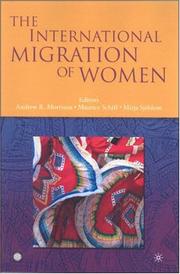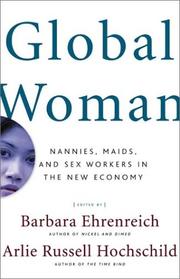| Listing 1 - 10 of 20 | << page >> |
Sort by
|
Book
ISBN: 0855323914 2825405612 Year: 1978 Publisher: London Search Press
Abstract | Keywords | Export | Availability | Bookmark
 Loading...
Loading...Choose an application
- Reference Manager
- EndNote
- RefWorks (Direct export to RefWorks)
Migration. Refugees --- Women --- Migrant labor --- Women alien labor --- Migration, Internal --- Femmes --- Travailleurs migrants --- Migration intérieure --- Employment --- Travail --- Women foreign workers --- Migration intérieure
Book
ISBN: 0253069173 9780253209048 Year: 1994 Publisher: Bloomington : Indiana University Press,
Abstract | Keywords | Export | Availability | Bookmark
 Loading...
Loading...Choose an application
- Reference Manager
- EndNote
- RefWorks (Direct export to RefWorks)
Women foreign workers --- Women immigrants --- History. --- Immigrant women --- Immigrants --- Foreign women workers --- Women alien labor --- Migrant women labor (Foreign workers) --- Migrant women workers (Foreign workers) --- Women migrant labor (Foreign workers) --- Women migrant workers (Foreign workers) --- Foreign workers --- Women employees
Book
ISBN: 9282571882 Year: 1987 Volume: vol *444
Abstract | Keywords | Export | Availability | Bookmark
 Loading...
Loading...Choose an application
- Reference Manager
- EndNote
- RefWorks (Direct export to RefWorks)
Occupational training for women --- Women alien labor --- Formation professionnelle des femmes --- Travailleuses étrangères --- Foreign women workers --- Migrant women labor (Foreign workers) --- Migrant women workers (Foreign workers) --- Women migrant labor (Foreign workers) --- Women migrant workers (Foreign workers) --- Foreign workers --- Women employees --- Women --- Employment --- Women foreign workers. --- Travailleuses étrangères --- Women foreign workers --- European communities --- Vocational guidance for women
Book
ISBN: 2747579751 233628362X 2940503907 2296390056 9782747579759 Year: 2005 Volume: 5 Publisher: Graduate Institute Publications
Abstract | Keywords | Export | Availability | Bookmark
 Loading...
Loading...Choose an application
- Reference Manager
- EndNote
- RefWorks (Direct export to RefWorks)
Le nouvel ordre économique néolibéral modifie la division internationale du travail, ce qui entraîne un accroissement des populations migrantes de travailleurs et de travailleuses. Actuellement, une personne sur dix dans les régions développées est migrante, et les femmes représentent la moitié de ce nombre. Longtemps, pourtant, la figure du migrant a été représentée comme masculine, en raison des représentations stéréotypées ou erronées du rôle et de la place des femmes et des hommes dans les sociétés, et les recherches ou programmes relatifs aux migrants ont ignoré la composante féminine des migrations. Or, les femmes migrent bien, elles aussi. Une grande partie des femmes migrantes – même qualifiées – travaillent dans le secteur des soins ou des emplois domestiques. Le transfert international des soins et de l’attention aux autres (care) – sorte de nouvelle matière première extraite des pays du Sud pour être consommée dans les pays riches – est un nouvel échange inégal. Les espaces où se réalise le travail des migrantes restent souvent invisibles, lieus de peu de droits. Si les discriminations et les abus sont à dénoncer, l’image de victime accolée aux migrantes et cependant loin de convenir. La trajectoire migratoire demande pugnacité et courage. Et nous pouvons nous demander s’il ne s’agit pas du départ des personnes les plus combatives de la société… Les identités se transforment dans l’expérience de la migration : comme le dit l’une d’elles, « je ne suis plus celle que j’ai laissée derrière moi ». Des réseaux transnationaux se construisent, accompagnés d’une circulation d’idées, de nouvelles représentations, de projets, de flux financiers. En 2002, les revenus du travail des migrants atteignaient 73 milliards de dollars, un montant plus élevé que celui de l’aide internationale au développement. Un nouvel ordre colonial s’instaure avec la nouvelle division internationale du travail. Mais les migrations des femmes et des hommes à travers les pratiques sociales…
International division of labor --- Emigration and immigration --- Women immigrants --- Division internationale du travail --- Emigration et immigration --- Immigrantes --- Women alien labor. --- International division of labor. --- Globalization --- Emigrant remittances --- Social conditions. --- Social aspects. --- Women immigrants - Social conditions. --- Globalization - Social aspects. --- Emigrant remittances - Developing countries. --- droits humains --- relations sexuelles --- féminisme --- division sexuelle du travail --- commerce international --- femmes --- développement économique --- relations hommes-femmes --- commerce équitable

ISBN: 1281113220 9786611113223 0821372289 0821372270 Year: 2007 Publisher: Washington, DC : World Bank,
Abstract | Keywords | Export | Availability | Bookmark
 Loading...
Loading...Choose an application
- Reference Manager
- EndNote
- RefWorks (Direct export to RefWorks)
The current share of women in the world's international migrant population is close to one half. Despite the great number of female migrants and their importance for the development agenda in countries of origin, there has until recently been a striking lack of gender analysis in the economic literature on international migration and development. This volume makes a valuable contribution in this context by providing eight new studies focusing on the nexus between gender, international migration, and economic development.
Women immigrants. --- Women foreign workers. --- Women --- Emigration and immigration --- Brain drain. --- Economic conditions. --- Economic aspects. --- Foreign women workers --- Women alien labor --- Migrant women labor (Foreign workers) --- Migrant women workers (Foreign workers) --- Women migrant labor (Foreign workers) --- Women migrant workers (Foreign workers) --- Immigrant women --- Foreign workers --- Women employees --- Immigrants
Book
ISBN: 9781501709418 1501709410 9781501712050 1501712055 9781501713149 1501713140 1501713159 Year: 2017 Publisher: Ithaca : Cornell University Press,
Abstract | Keywords | Export | Availability | Bookmark
 Loading...
Loading...Choose an application
- Reference Manager
- EndNote
- RefWorks (Direct export to RefWorks)
"Sex, Love, and Migration goes beyond a common narrative of women's exploitation as a feature of migration in the early twenty-first century, a story that features young women from poor countries who cross borders to work in low paid and often intimate labor. Alexia Bloch argues that the mobility of women is marked not only by risks but also by personal and social transformation as migration fundamentally reshapes women's emotional worlds and aspirations. Bloch documents how, as women have crossed borders between the former Soviet Union and Turkey since the early 1990s, they have forged new forms of intimacy in their households in Moldova, Ukraine, Belarus, and Russia, but also in Istanbul, where they often work for years on end. Sex, Love, and Migration takes as its subject the lives of post-Soviet migrant women employed in three distinct spheres--sex work, the garment trade, and domestic work. Bloch challenges us to decouple images of women on the move from simple assumptions about danger, victimization, and trafficking. She redirects our attention to the aspirations and lives of women who, despite myriad impediments, move between global capitalist centers and their home communities"--
Post-communism --- Transnationalism --- Women foreign workers --- Foreign women workers --- Women alien labor --- Migrant women labor (Foreign workers) --- Migrant women workers (Foreign workers) --- Women migrant labor (Foreign workers) --- Women migrant workers (Foreign workers) --- Foreign workers --- Women employees --- Trans-nationalism --- Transnational migration --- International relations
Book
ISBN: 8411228517 Year: 2022 Publisher: Madrid : Dykinson S.L.,
Abstract | Keywords | Export | Availability | Bookmark
 Loading...
Loading...Choose an application
- Reference Manager
- EndNote
- RefWorks (Direct export to RefWorks)
Women foreign workers --- Women immigrants --- Social conditions. --- Labor laws and legislation --- Immigrant women --- Immigrants --- Foreign women workers --- Women alien labor --- Migrant women labor (Foreign workers) --- Migrant women workers (Foreign workers) --- Women migrant labor (Foreign workers) --- Women migrant workers (Foreign workers) --- Foreign workers --- Women employees

ISBN: 9780520251717 Year: 2007 Publisher: Berkeley, Calif. University of California Press
Abstract | Keywords | Export | Availability | Bookmark
 Loading...
Loading...Choose an application
- Reference Manager
- EndNote
- RefWorks (Direct export to RefWorks)
Migration. Refugees --- Sociology of minorities --- Sociology of the family. Sociology of sexuality --- Sociology of work --- California --- Women household employees --- Nannies --- Hispanic American women --- Women alien labor --- Women immigrants --- Working class women --- Upper class women --- Employées de maison --- Bonnes d'enfants --- Femmes d'origine latino-américaine --- Travailleuses étrangères --- Immigrantes --- Travailleuses --- Femmes de la classe supérieure --- Employment --- Economic conditions --- Travail --- Women foreign workers --- Employées de maison --- Femmes d'origine latino-américaine --- Travailleuses étrangères --- Femmes de la classe supérieure --- California [state]

ISBN: 080506995X 0805075097 9780805075090 Year: 2004 Publisher: New York (N.Y.) : Metropolitan/Owl Books,
Abstract | Keywords | Export | Availability | Bookmark
 Loading...
Loading...Choose an application
- Reference Manager
- EndNote
- RefWorks (Direct export to RefWorks)
In a remarkable pairing, two renowned social critics offer a groundbreaking anthology that examines the unexplored consequences of globalization on the lives of women worldwide. Women are moving around the globe as never before. But for every female executive racking up frequent flier miles, there are multitudes of women whose journeys go unnoticed. Each year, millions leave Mexico, Sri Lanka, the Philippines, and other third world countries to work in the homes, nurseries, and brothels of the first world. This broad-scale transfer of labor associated with women's traditional roles results in an odd displacement. In the new global calculus, the female energy that flows to wealthy countries is subtracted from poor ones, often to the detriment of the families left behind. The migrant nanny--or cleaning woman, nursing care attendant, maid--eases a "care deficit" in rich countries, while her absence creates a "care deficit" back home. Confronting a range of topics, from the fate of Vietnamese mail-order brides to the importation of Mexican nannies in Los Angeles and the selling of Thai girls to Japanese brothels, "Global woman offers an unprecedented look at a world shaped by mass migration and economic exchange on an ever-increasing scale. In fifteen vivid essays--of which only four have been previously published--by a diverse and distinguished group of writers, collected and introduced by best selling authors Barbara Ehrenreich and Arlie Russell Hochschild, this anthology reveals a new era in which the main resource extracted from the third world is no longer gold or silver, but love.
Women household employees --- Women foreign workers --- Women --- Minority women --- Nannies --- Prostitution --- Employées de maison --- Travailleuses étrangères --- Femmes --- Femmes issues des minorités --- Bonnes d'enfants --- Employment --- Travail --- Women domestics. --- Women alien labor. --- Nannies. --- Prostitution. --- Employment. --- Employées de maison --- Travailleuses étrangères --- Femmes issues des minorités --- Kvinnor på arbetsmarknaden. --- Hushållsarbete. --- Transnationalisering. --- Migration --- Women household employees. --- Women foreign workers. --- Trabalho feminino. --- Emprego. --- Mulheres (aspectos socioeconômicos). --- Globalisierung. --- Hausgehilfin. --- Frauenarbeit. --- Niedriglohn. --- Transnationalism. --- Genusaspekter. --- Women - Employment. --- Minority women - Employment.
Book
ISBN: 9089643273 9786613643933 9048514479 1280667001 9789048514472 9789089643278 Year: 2012 Publisher: Amsterdam Amsterdam University Press
Abstract | Keywords | Export | Availability | Bookmark
 Loading...
Loading...Choose an application
- Reference Manager
- EndNote
- RefWorks (Direct export to RefWorks)
This book is about migration as a form of risk-taking. Based on Ukrainian women's experiences in the Polish domestic work sector, it presents a new approach to analyse movements of female migrants responding to the demand for household labour around the world. Risks involved in migration and in migrant domestic work are accounted for in detail alongside an analysis of the migration decision-making processes. This study shows how social ties and migrant institutions effectively reduce the otherwise radical asymmetry of power between an individual migrant, the state and an employer. A Risky Business? brings to light the complex risk structures of migrants' activities and their sophisticated responses to them. With their innovative strategies, migrants challenge government-imposed constraints and thus reduce the risks of migration.
Women foreign workers --- Foreign women workers --- Women alien labor --- Migrant women labor (Foreign workers) --- Migrant women workers (Foreign workers) --- Women migrant labor (Foreign workers) --- Women migrant workers (Foreign workers) --- Foreign workers --- Women employees --- Household employees --- Ukrainians --- Migration, Internal --- E-books --- Ethnology --- Slavs, Eastern --- Ruthenians --- Domestic employees --- Domestic service employees --- Domestic service workers --- Domestics --- Household staff --- Household workers --- Servants --- Service employees, Domestic --- Service workers, Domestic --- Employees
| Listing 1 - 10 of 20 | << page >> |
Sort by
|

 Search
Search Feedback
Feedback About UniCat
About UniCat  Help
Help News
News